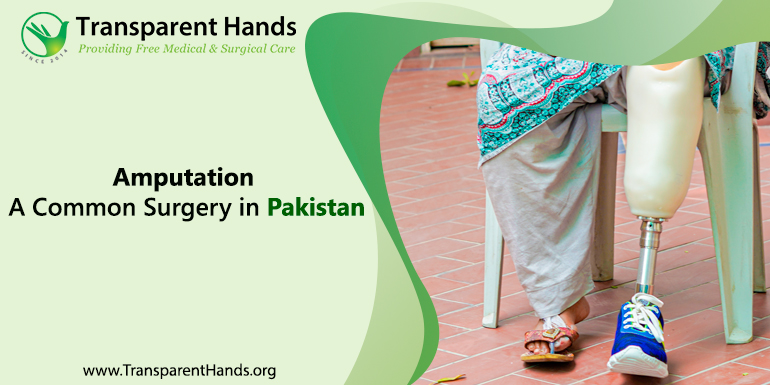Amputation: A common surgery in Pakistan

Amputation is the loss of body parts like toes, fingers, arms, legs, or hands due to trauma or surgery. Sometimes, surgical amputation becomes a necessity to save a patient’s life. It is a life-changing experience for patients who face several challenges including the inability to stand up and walk. Such patients may also need psychological help in addition to prosthetics therapy.
Types of Amputation
Curative Amputation
The amputations carried out to treat life-threatening medical conditions are curative. Patients with refractory diabetes are often at the receiving end of such treatments. And the amputation usually involves legs and feet as they are affected by gangrene or other infections.
Preventive Amputation
Preventive amputations are done to save patients from a medical condition that they can develop later in life. Usually, patients with a high risk of certain malignancies undergo this type of amputation.
Accidental Amputation
Machinal accidents in industrial settings are among the leading causes of amputations. Although many strict measures are in place to prevent these accidents, they do happen now
and then. Road accidents can also lead to amputations.
Reason For Amputation
Medically, there are several conditions that require surgical amputation to save the patient’s life. Some of these conditions include:
Diabetes
Diabetic patients have impaired physical ability to heal themselves from infections. Pain receptors in such patients are also often desensitized. Patients unknowingly suffer from the infection and know about it only when it has already spread widely. The feet of patients are usually affected. That is precisely why health professionals recommend soft footwear for such patients.
If the infection goes untreated, it can convert into gangrene which is dead tissue. It releases several toxic chemicals into the bloodstream that can be potentially fatal. Hence, surgeons have to remove the affected part to prevent the potential damage it can cause to other body parts.
Deep Vein Thrombosis
Patients that are hospitalized or have limited mobility due to any medical condition are at increased risk of deep vein thrombosis. Because of immobility, clots begin to develop which can block the flow of blood in the legs. Impaired circulation deprives the tissue of nutrients which consequently leads to tissue death. The cytokine release following the tissue death can lead to cardiopulmonary events and cause the patient’s death.
Physicians try to resolve the clot with medication and minimally invasive techniques, but if the damage is severe, the patients have to undergo amputation.
Frostbite
Extremely cold temperatures can produce frostbite. Tissues of the body that are not covered experience protein, lipid, and electrolyte disruption which ultimately cause necrosis. The affected area turns black and the blood supply gets blocked. Mild to moderate frostbites can resolve with medications but severe frostbites need an amputation.
Neuromas
Neuromas are essentially tumors also known as pinched nerves. They usually originate between the third and fourth toes and bring a great deal of pain, burning sensation, and numbness to the area. To eliminate the chronic pain, the surgeon may have to amputate the entire area.
Cancerous Tumors in Bone or Muscle
Tumors can also develop in the muscles and bones of our limbs. While benign tumors are usually harmless, cancerous tumors can migrate and affect other parts of the body. In the latter case, surgeons have to intervene and take the tumors out. But if the location of growth is such that it cannot be removed without removing the bones or muscles of the area, surgeons may have to amputate such limbs in the greater interest of the patient’s health.
Procedure of Amputation
The overall procedure changes with respect to the part or the type of limb that is being amputated. However, there are certain things that remain the same.
- Amputations are done under general anesthesia to prevent psychological trauma.
- Surgeons remove all the affected tissue but try to keep as much healthy tissue they can.
- Depending on the procedure, the surgeon may close the wound or keep it open for further tissue resection.
- All the blood vessels are sealed, bones are smoothened and shaped to support artificial limbs in the future.
- It requires five to fourteen days of hospital stay for monitoring of complications.
Recovery From Amputation
Recovery from amputation greatly depends on the type and extent of tissue removal. Health conditions like diabetes and hypertension can increase recovery time. Many patients also need physiological help in addition to physical and occupational therapy.
Physical therapy increases the strength of the remaining muscles and bones. Occupational therapy teaches patients to cope with physical challenges associated with such procedures. Physiological sessions help patients in dealing with the emotional trauma of losing a body part and the resultant emotional burden.
Bottom Line
Amputation is a life-saving procedure but the patients face a lot of emotional and physical challenges. That said, it is an expensive procedure, and not all patients can afford it. Not only does Transparent Hands provide free amputation surgeries to deserving patients but also helps them get back on their feet by equipping them with artificial limbs. Donate now to support this cause.










Leave Your Comments